Brook mentioned a few things above that are interesting and insightful. First, about Indian Stripe, a tomato that Carolyn Male fancifully linked to Cherokee Purple. She surmised that just because Indian Stripe had been grown in a particular area of Arkansas reportedly for a few generations, and because there was a presence in Arkansas of the Western Nation, that there could be a direct kinship between Indian Stripe and Cherokee Purple.
Well, that would be like me saying that just because there's a long established Amish community in Southern Indiana (and Western Kentucky for that matter), and just because I ran across a large, tasty tomato from a non-Amish gardener living in close proximity to the Amish community (remember, the Indian Stripe tomato didn't come from a member of the Western Cherokee Nation ... it came from a local, non-native-American gardener), that what I have is a Brandywine derivative. Now, we know that would be rediculous, right? Ask Alan how many flats of Better Boy transplants he sold to an Amish farmer this spring ... and I've bought several Randy Gardner/Mountain Series tomatoes from a street vendor here who buys directly from the Amish. I guess I could assume those are big, hard, not-so-tasty Brandies :::smile:::
Also ... Cherokee Purple has shown tendencies to, in some people's words, "mutate." Since its introduction to the commercial seed arena. Now we have Cherokee Green, Cherokee Chocolate, Cherokee Purple Potato Leaf, and some Cherokee Whatevers that have flopped back from Potato Leaf to Regular Leaf, and from Green to Red, and now even from Potato Leaf to small red pointy potato leaf!!!
Oh well ... enough blathering about Cherokee Purple ... let's enjoy some pictures ...
Indian Stripe (aka Indian Zebra) originally from Arkansas ... seeds purchased from Victory Seeds ... grown in 2006 in Warrick County, Indiana. These show it to be a bit smaller (baseball size) and not so oblate as Cherokee Purple. Indian Stripe however is more size consistent and tastes as good as any Cherokee Purple I ever grew.
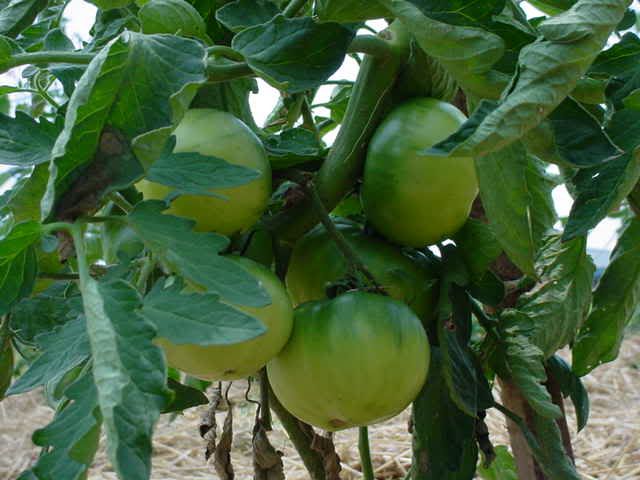
Indian Stripe breaking color. Seems, if anything, to be a tad "redder" in appearance than Cherokee Purple at this stage, but still has clear epidermis.
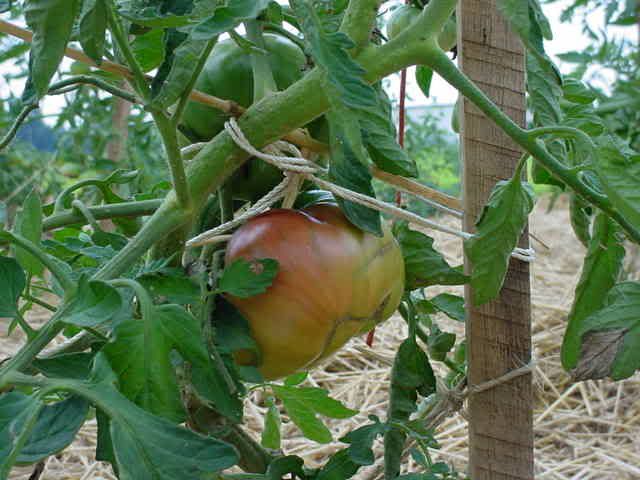
Picked on the green side, one can still see the green stripes that account for its name.
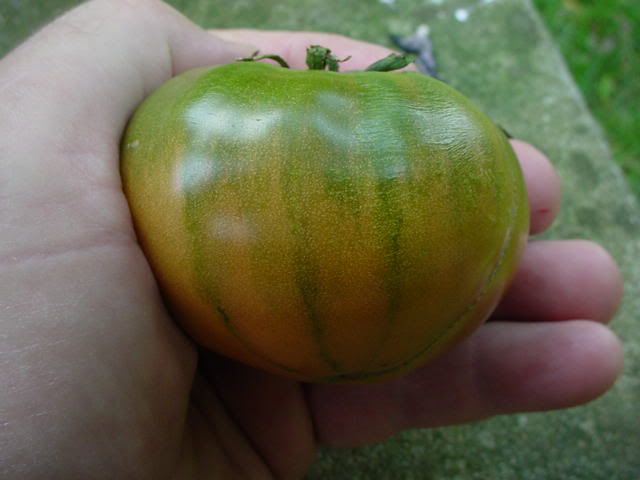
However, I've seen Cherokee Purple have green shoulder stripes that extend down into the midsections of the fruit ... just not all the way to the blossom ends like this fruit.
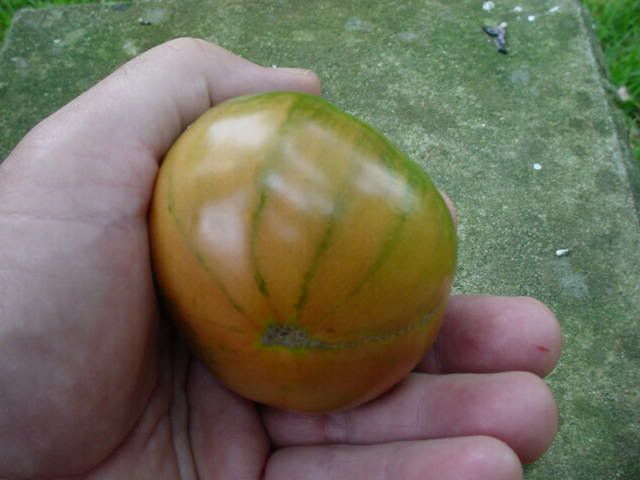
Same tomato after ripening inside for a day or two.
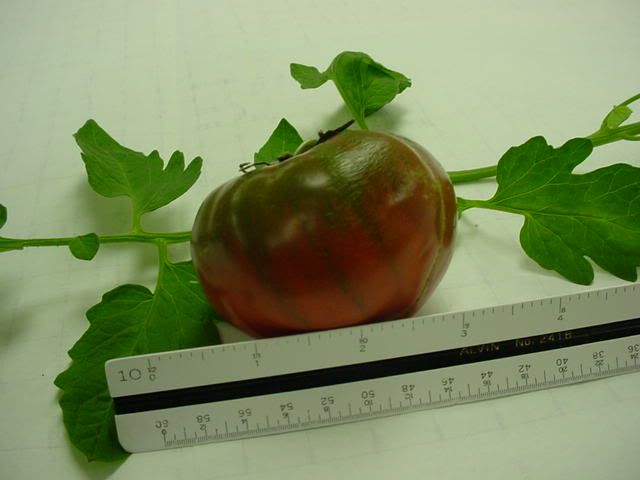
And the stripes on the blossom end after a day or two.
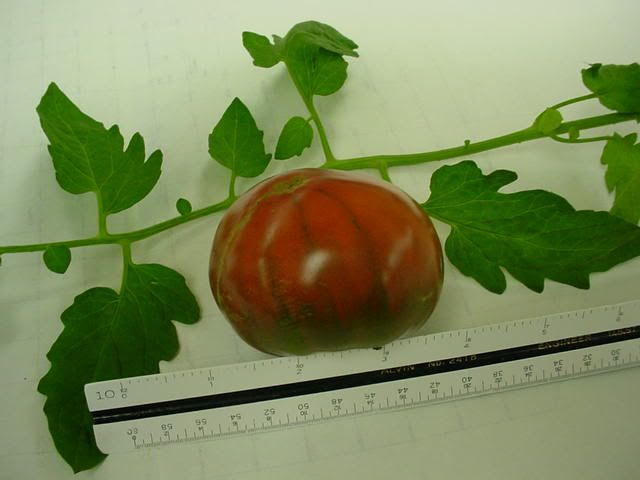
Again ... notice the redder appearance of Indian Stripe compared with what you may have seen on Cherokee Purple. Like I said, it still has a clear epidermis, therefore is a "pink" tomato and not a "red" tomato with a yellow epidermis.
This "reddish" appearance was common among all the tomatoes on all ten of the Indian Stripe plants I grew that year. Here is one that has no stripes from a plant that made fruit with no visible striping that gives it the name.
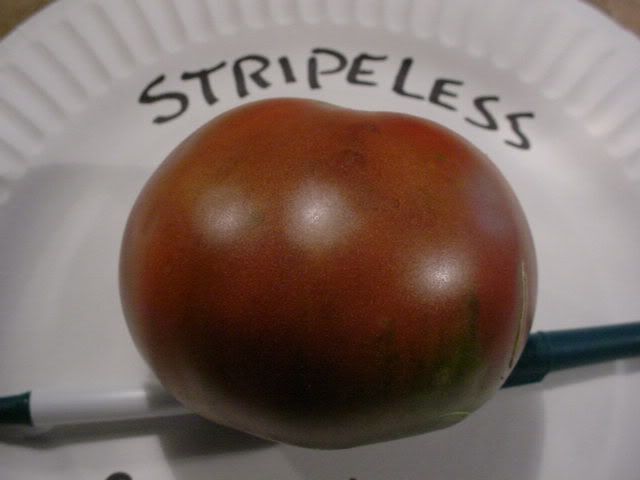
... and the blossom end of the same tomato ...
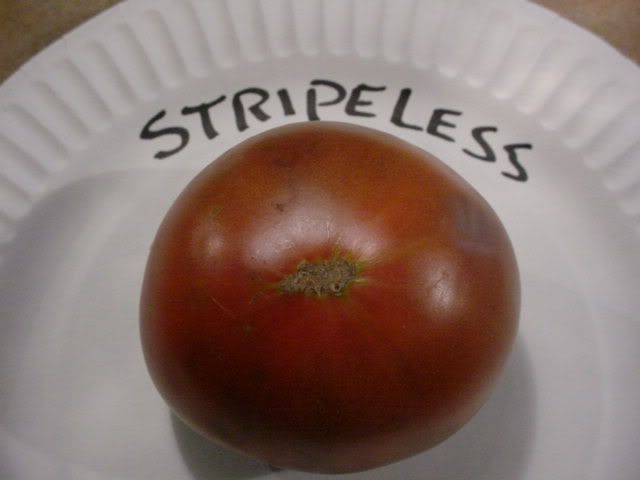
I even had one plant that made RED tomatoes ... yes, with yellow epidermis and solid red appearance. And yes, it was from the same packet of Victory Seeds for Indian Stripe. Go figure. Unfortunately, I don't have a picture of it in my photobucket ... I'm sure I have a picture of it in my files, and will post it later if I retrieve it.
Anyway ... here is Indian Stripe sliced open so you can see the typical cross section.
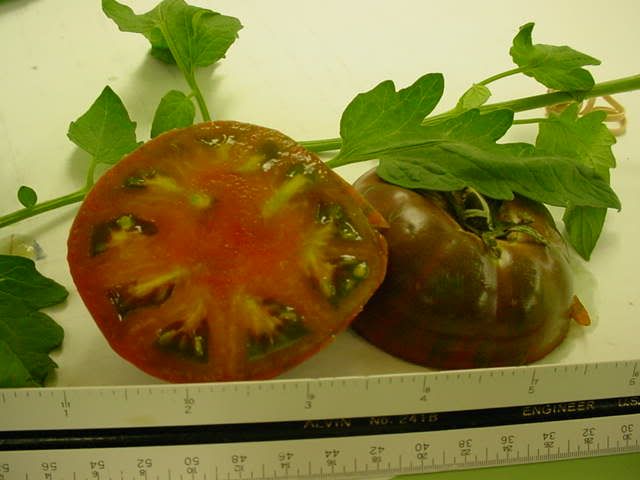
So ... as you can see ... it resembles Cherokee Purple ... but that doesn't automatically make it a Cherokee Brother.
Now ... Cherokee Green, supposedly a direct mutation from Cherokee Purple. Again the seeds are from Victory Seed Company who got their original supply from Craig LeHoullier.

... and the blossom end ... yes, this tomato is ripe and ready to eat ... and DELICIOUS it was!
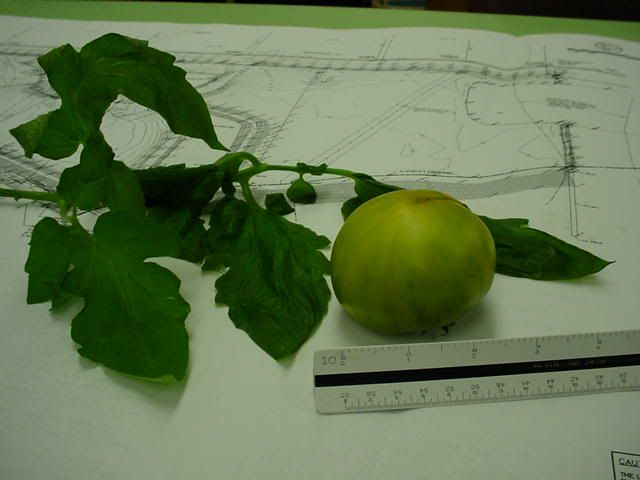
... and the sliced cross section ...
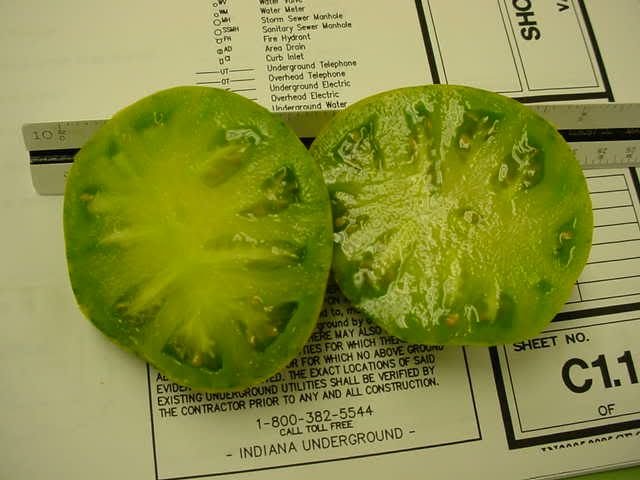
I don't recall right now the order of supposed mutation here from Purple to Green to Chocolate ... blah, blah, blah ... but the supposition is "mutation" and not "crossed seed." But like I said above, I have reports from friends that their Greens throw Reds and Golds (yellow epidermis), etc. ... so who knows what beevil lurks in Carolina gardens?
Now ... as to leaf form ... Cherokee Purple is supposed to be regular leaf (normal leaf). But there is a Cherokee Purple with potato leaf. Here is the leaf form.

I got my seeds from Tom in New Jersey, who got his seeds from Bill Malin (Spudleaf Willie) in New Mexico. Spudleaf only grows potato leaf tomatoes ... he has a collection of over 700 potato leaf types. He got his seeds for Cherokee Purple from a gardener in Ohio BEFORE Jere Gettle found his supposed Cherokee Purple Potato Leaf growing in his Missouri garden ... the one he distributed via Seed Savers Exchange.
Here is some green fruit on my plant from the Bill Malin collection.
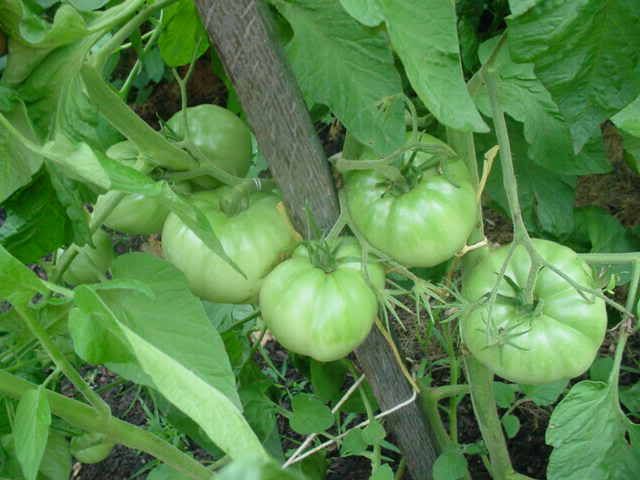
Here's one on the potato leaf plant breaking color two days ago (75 days from transplant).
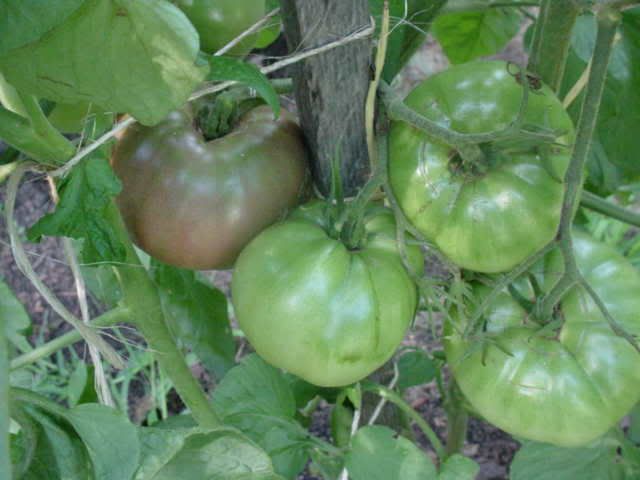
You may compare the shape and size to this Cherokee Purple regular leaf growing right next to it.
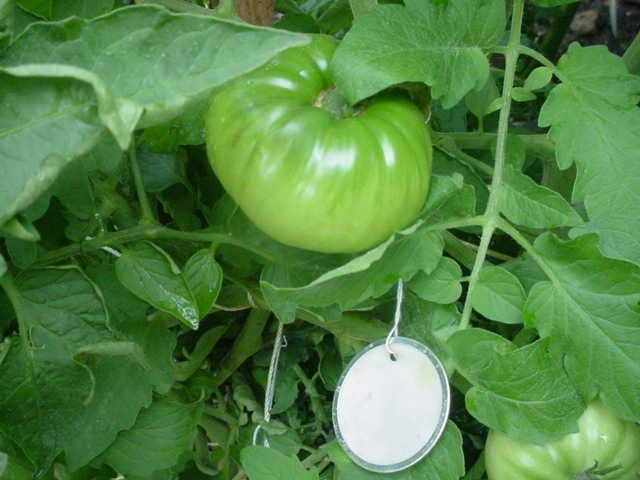
Well ... that's about it for my Saturday morning pictorial ... oh ... except for this dandy shot of the Garden Snake ... every Garden needs a Snake, right?
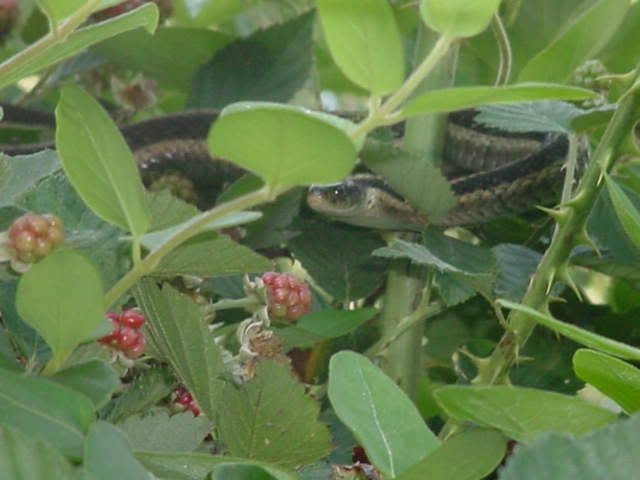
Beware Little Birdies!!!
Oh yeah ... and here's a link to another discussion of Cherokee Purple and how folks are finding discrepancies in their seed. Read particularly Cozy's lament ... how he bought 1/4 ounce of Cherokee Purple seeds from Baker Creek only to get what is pictured there as a small, pointed, red tomato on a potato leaf vine. Hahahahaha. (Gawd, I'm cruel for laughing). It doesn't seem to be a seed mixup on his part since his friends in several states shared the seed and got the same results.
Also note Korney's lament on how his Cherokee Purple seeds from Bill Malin (same source as mine) "reverted" to regular leaf ... not likely a "mutation" at 100% reversion ... that would indicate a F1 cross with a regular leaf parent. Korney needs to grow out some F2s and see if he gets 25% potato leaf before making any assumptions. BTW my Malin seeds were 100% potato leaf.
forums.gardenweb.com/forums/load/tomato/msg061625206406.html?10If you happen to notice that HoosierCherokee's pics look like mine ... they are!
Enjoy Cherokee Purple (and Green, and Chocolate, and PL, and Indian Stripe), they are wonderful tomatoes.
Bill